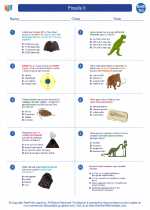Fossils II -> atom
Atom
An atom is the basic unit of matter, consisting of a nucleus and one or more electrons that orbit the nucleus. The nucleus contains protons and neutrons, which are held together by strong nuclear forces. The electrons are negatively charged particles that orbit the nucleus in specific energy levels.
Atomic Structure
The nucleus of an atom is composed of protons and neutrons. Protons have a positive charge, while neutrons have no charge. The number of protons in the nucleus determines the element's identity and is known as the atomic number. The sum of protons and neutrons in the nucleus gives the atomic mass number.
Electron Cloud
The electrons orbit the nucleus in specific energy levels or shells, forming a cloud around the nucleus. These energy levels are designated by quantum numbers and can hold a specific number of electrons. The outermost shell is known as the valence shell and determines the atom's chemical properties.
Atomic Models
Several models have been proposed to describe the structure of the atom, including the Bohr model, the quantum mechanical model, and the electron cloud model. Each model provides a different perspective on how electrons behave within the atom.
Subatomic Particles
Atoms are composed of subatomic particles, including protons, neutrons, and electrons. Protons and neutrons are found in the nucleus, while electrons orbit the nucleus in energy levels. These particles have distinct properties and play a crucial role in the behavior of atoms.
Study Guide
- What is an atom?
- Describe the structure of an atom.
- Explain the role of protons, neutrons, and electrons in an atom.
- Discuss the significance of the atomic number and atomic mass number.
- Compare and contrast the different atomic models.
- How do energy levels and valence shells contribute to an atom's chemical properties?



